Cultural Bias in Healthcare: Report on LGBT Experiences & Solutions
VerifiedAdded on 2023/06/11
|8
|2511
|430
Report
AI Summary
This report explores the issue of biased treatment within healthcare settings, focusing on the experiences of the LGBT community. It examines how intersectionality, cultural differences, and societal perceptions contribute to discrimination and inequalities in healthcare access and quality. The report analyzes barriers such as low income and lack of education that exacerbate these issues, while also highlighting the importance of cultural safety and respectful communication in healthcare practices. Furthermore, it discusses advocacy strategies at the population level to promote institutional changes, influence health policies, and foster community development initiatives that ensure equal healthcare services for all individuals, regardless of their gender, sexuality, or cultural background. The report concludes by emphasizing the need to address cultural biases and promote equitable healthcare practices to improve health outcomes for the LGBT population.
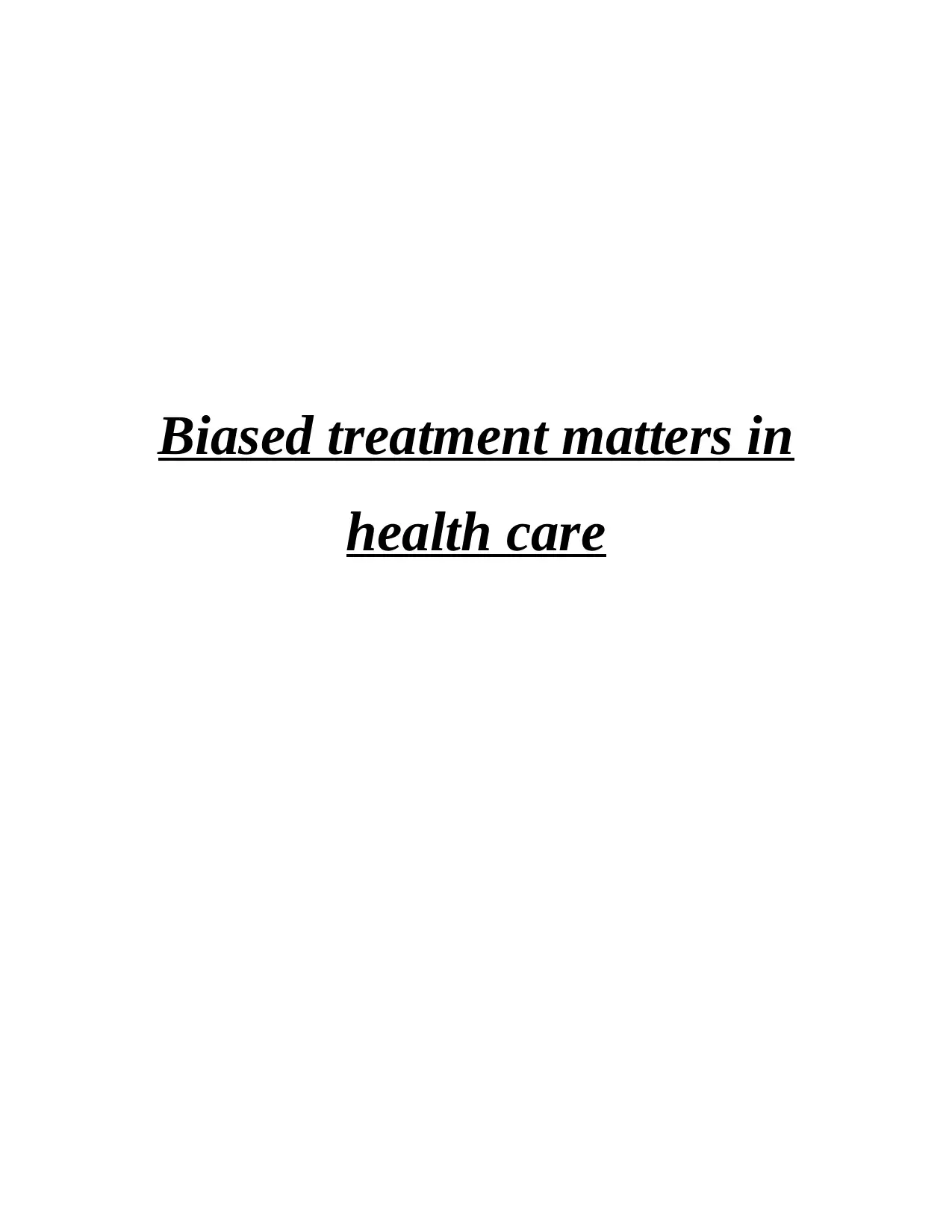
Biased treatment matters in
health care
health care
Paraphrase This Document
Need a fresh take? Get an instant paraphrase of this document with our AI Paraphraser
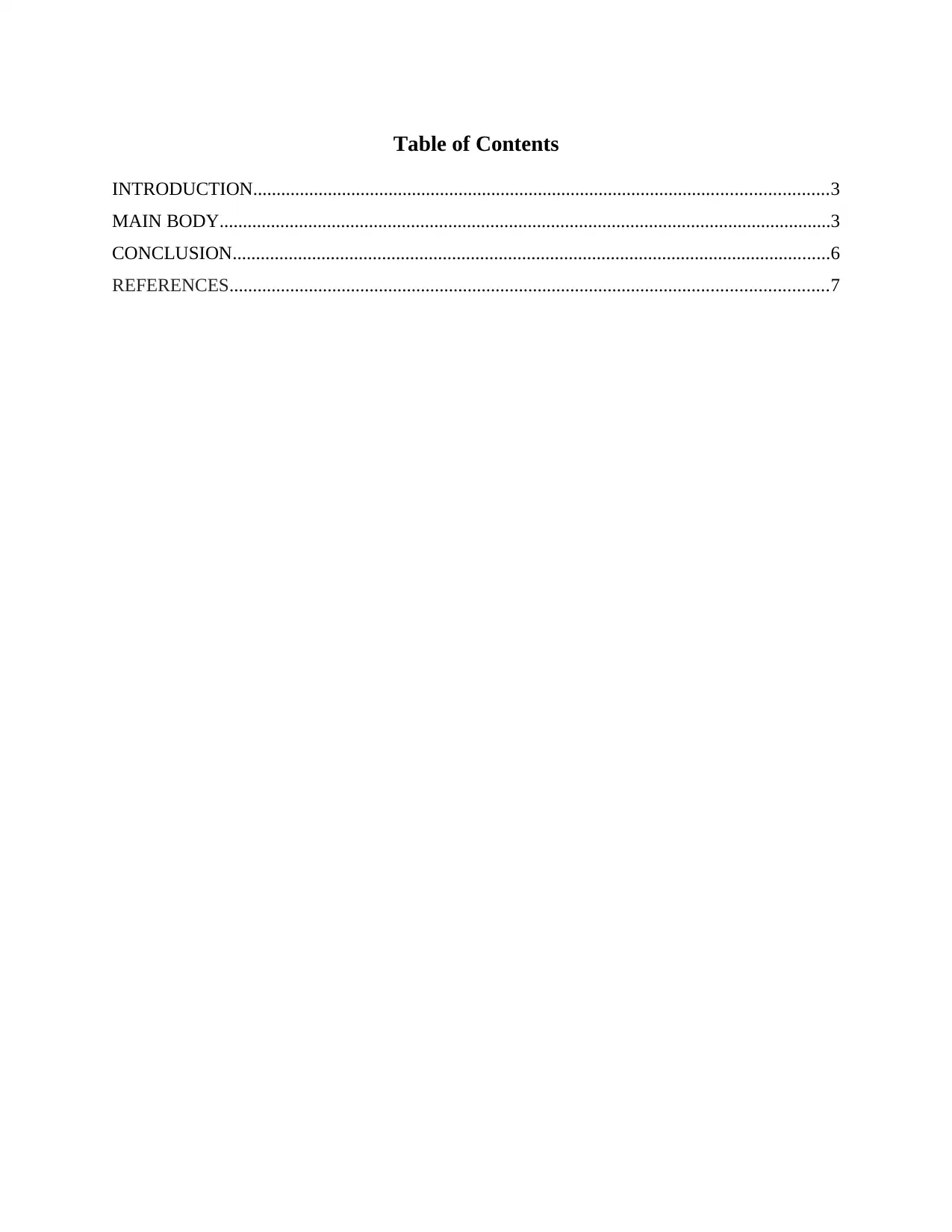
Table of Contents
INTRODUCTION...........................................................................................................................3
MAIN BODY...................................................................................................................................3
CONCLUSION................................................................................................................................6
REFERENCES................................................................................................................................7
INTRODUCTION...........................................................................................................................3
MAIN BODY...................................................................................................................................3
CONCLUSION................................................................................................................................6
REFERENCES................................................................................................................................7
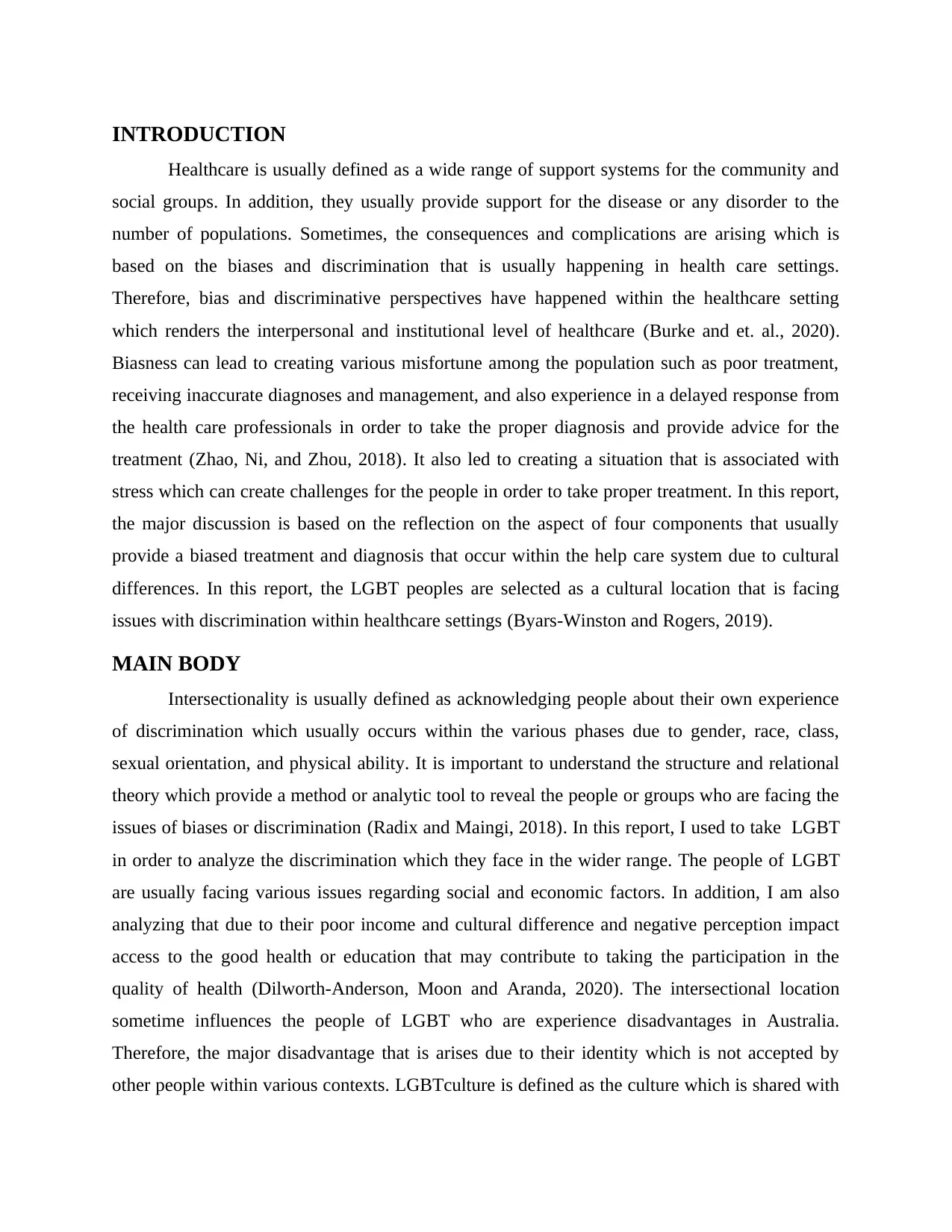
INTRODUCTION
Healthcare is usually defined as a wide range of support systems for the community and
social groups. In addition, they usually provide support for the disease or any disorder to the
number of populations. Sometimes, the consequences and complications are arising which is
based on the biases and discrimination that is usually happening in health care settings.
Therefore, bias and discriminative perspectives have happened within the healthcare setting
which renders the interpersonal and institutional level of healthcare (Burke and et. al., 2020).
Biasness can lead to creating various misfortune among the population such as poor treatment,
receiving inaccurate diagnoses and management, and also experience in a delayed response from
the health care professionals in order to take the proper diagnosis and provide advice for the
treatment (Zhao, Ni, and Zhou, 2018). It also led to creating a situation that is associated with
stress which can create challenges for the people in order to take proper treatment. In this report,
the major discussion is based on the reflection on the aspect of four components that usually
provide a biased treatment and diagnosis that occur within the help care system due to cultural
differences. In this report, the LGBT peoples are selected as a cultural location that is facing
issues with discrimination within healthcare settings (Byars-Winston and Rogers, 2019).
MAIN BODY
Intersectionality is usually defined as acknowledging people about their own experience
of discrimination which usually occurs within the various phases due to gender, race, class,
sexual orientation, and physical ability. It is important to understand the structure and relational
theory which provide a method or analytic tool to reveal the people or groups who are facing the
issues of biases or discrimination (Radix and Maingi, 2018). In this report, I used to take LGBT
in order to analyze the discrimination which they face in the wider range. The people of LGBT
are usually facing various issues regarding social and economic factors. In addition, I am also
analyzing that due to their poor income and cultural difference and negative perception impact
access to the good health or education that may contribute to taking the participation in the
quality of health (Dilworth-Anderson, Moon and Aranda, 2020). The intersectional location
sometime influences the people of LGBT who are experience disadvantages in Australia.
Therefore, the major disadvantage that is arises due to their identity which is not accepted by
other people within various contexts. LGBTculture is defined as the culture which is shared with
Healthcare is usually defined as a wide range of support systems for the community and
social groups. In addition, they usually provide support for the disease or any disorder to the
number of populations. Sometimes, the consequences and complications are arising which is
based on the biases and discrimination that is usually happening in health care settings.
Therefore, bias and discriminative perspectives have happened within the healthcare setting
which renders the interpersonal and institutional level of healthcare (Burke and et. al., 2020).
Biasness can lead to creating various misfortune among the population such as poor treatment,
receiving inaccurate diagnoses and management, and also experience in a delayed response from
the health care professionals in order to take the proper diagnosis and provide advice for the
treatment (Zhao, Ni, and Zhou, 2018). It also led to creating a situation that is associated with
stress which can create challenges for the people in order to take proper treatment. In this report,
the major discussion is based on the reflection on the aspect of four components that usually
provide a biased treatment and diagnosis that occur within the help care system due to cultural
differences. In this report, the LGBT peoples are selected as a cultural location that is facing
issues with discrimination within healthcare settings (Byars-Winston and Rogers, 2019).
MAIN BODY
Intersectionality is usually defined as acknowledging people about their own experience
of discrimination which usually occurs within the various phases due to gender, race, class,
sexual orientation, and physical ability. It is important to understand the structure and relational
theory which provide a method or analytic tool to reveal the people or groups who are facing the
issues of biases or discrimination (Radix and Maingi, 2018). In this report, I used to take LGBT
in order to analyze the discrimination which they face in the wider range. The people of LGBT
are usually facing various issues regarding social and economic factors. In addition, I am also
analyzing that due to their poor income and cultural difference and negative perception impact
access to the good health or education that may contribute to taking the participation in the
quality of health (Dilworth-Anderson, Moon and Aranda, 2020). The intersectional location
sometime influences the people of LGBT who are experience disadvantages in Australia.
Therefore, the major disadvantage that is arises due to their identity which is not accepted by
other people within various contexts. LGBTculture is defined as the culture which is shared with
⊘ This is a preview!⊘
Do you want full access?
Subscribe today to unlock all pages.

Trusted by 1+ million students worldwide
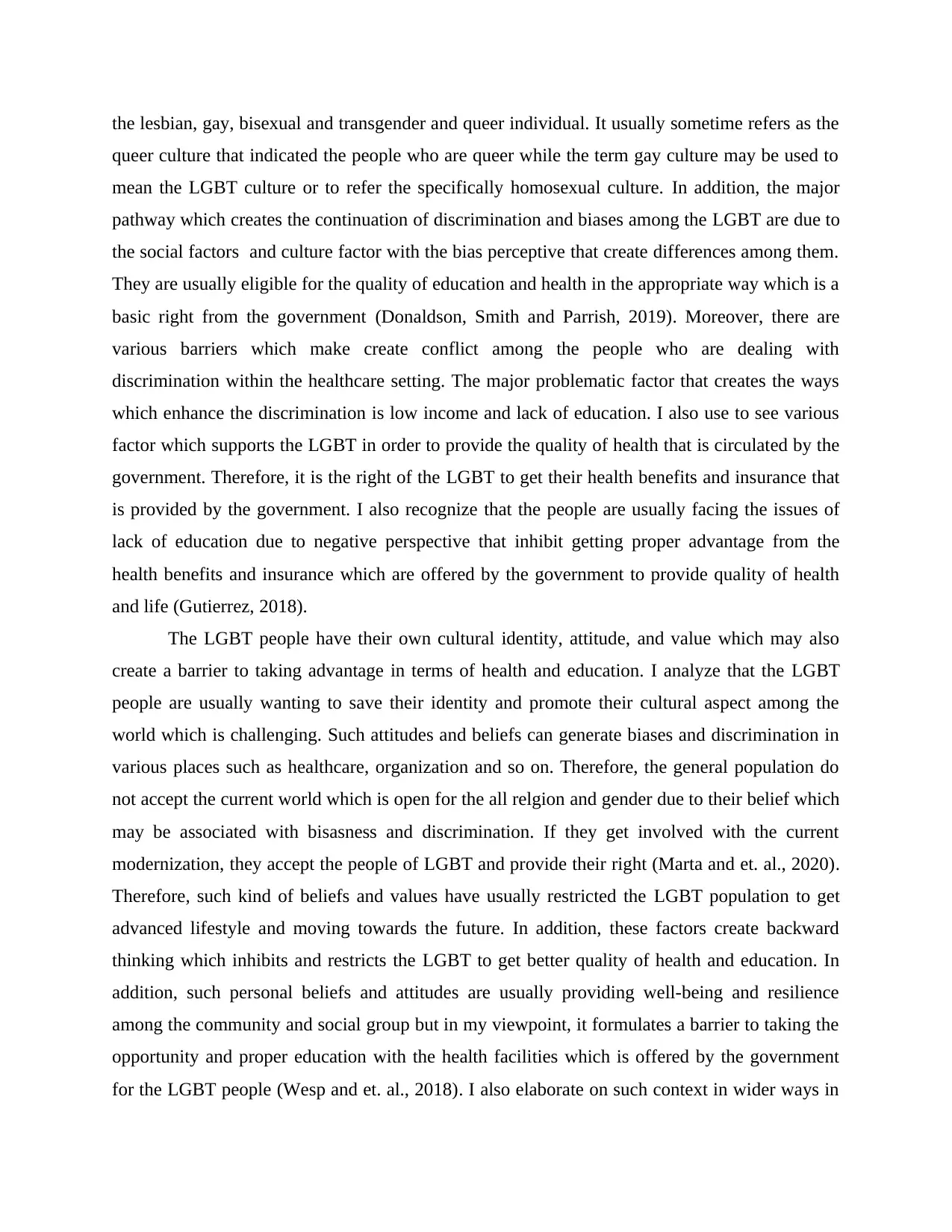
the lesbian, gay, bisexual and transgender and queer individual. It usually sometime refers as the
queer culture that indicated the people who are queer while the term gay culture may be used to
mean the LGBT culture or to refer the specifically homosexual culture. In addition, the major
pathway which creates the continuation of discrimination and biases among the LGBT are due to
the social factors and culture factor with the bias perceptive that create differences among them.
They are usually eligible for the quality of education and health in the appropriate way which is a
basic right from the government (Donaldson, Smith and Parrish, 2019). Moreover, there are
various barriers which make create conflict among the people who are dealing with
discrimination within the healthcare setting. The major problematic factor that creates the ways
which enhance the discrimination is low income and lack of education. I also use to see various
factor which supports the LGBT in order to provide the quality of health that is circulated by the
government. Therefore, it is the right of the LGBT to get their health benefits and insurance that
is provided by the government. I also recognize that the people are usually facing the issues of
lack of education due to negative perspective that inhibit getting proper advantage from the
health benefits and insurance which are offered by the government to provide quality of health
and life (Gutierrez, 2018).
The LGBT people have their own cultural identity, attitude, and value which may also
create a barrier to taking advantage in terms of health and education. I analyze that the LGBT
people are usually wanting to save their identity and promote their cultural aspect among the
world which is challenging. Such attitudes and beliefs can generate biases and discrimination in
various places such as healthcare, organization and so on. Therefore, the general population do
not accept the current world which is open for the all relgion and gender due to their belief which
may be associated with bisasness and discrimination. If they get involved with the current
modernization, they accept the people of LGBT and provide their right (Marta and et. al., 2020).
Therefore, such kind of beliefs and values have usually restricted the LGBT population to get
advanced lifestyle and moving towards the future. In addition, these factors create backward
thinking which inhibits and restricts the LGBT to get better quality of health and education. In
addition, such personal beliefs and attitudes are usually providing well-being and resilience
among the community and social group but in my viewpoint, it formulates a barrier to taking the
opportunity and proper education with the health facilities which is offered by the government
for the LGBT people (Wesp and et. al., 2018). I also elaborate on such context in wider ways in
queer culture that indicated the people who are queer while the term gay culture may be used to
mean the LGBT culture or to refer the specifically homosexual culture. In addition, the major
pathway which creates the continuation of discrimination and biases among the LGBT are due to
the social factors and culture factor with the bias perceptive that create differences among them.
They are usually eligible for the quality of education and health in the appropriate way which is a
basic right from the government (Donaldson, Smith and Parrish, 2019). Moreover, there are
various barriers which make create conflict among the people who are dealing with
discrimination within the healthcare setting. The major problematic factor that creates the ways
which enhance the discrimination is low income and lack of education. I also use to see various
factor which supports the LGBT in order to provide the quality of health that is circulated by the
government. Therefore, it is the right of the LGBT to get their health benefits and insurance that
is provided by the government. I also recognize that the people are usually facing the issues of
lack of education due to negative perspective that inhibit getting proper advantage from the
health benefits and insurance which are offered by the government to provide quality of health
and life (Gutierrez, 2018).
The LGBT people have their own cultural identity, attitude, and value which may also
create a barrier to taking advantage in terms of health and education. I analyze that the LGBT
people are usually wanting to save their identity and promote their cultural aspect among the
world which is challenging. Such attitudes and beliefs can generate biases and discrimination in
various places such as healthcare, organization and so on. Therefore, the general population do
not accept the current world which is open for the all relgion and gender due to their belief which
may be associated with bisasness and discrimination. If they get involved with the current
modernization, they accept the people of LGBT and provide their right (Marta and et. al., 2020).
Therefore, such kind of beliefs and values have usually restricted the LGBT population to get
advanced lifestyle and moving towards the future. In addition, these factors create backward
thinking which inhibits and restricts the LGBT to get better quality of health and education. In
addition, such personal beliefs and attitudes are usually providing well-being and resilience
among the community and social group but in my viewpoint, it formulates a barrier to taking the
opportunity and proper education with the health facilities which is offered by the government
for the LGBT people (Wesp and et. al., 2018). I also elaborate on such context in wider ways in
Paraphrase This Document
Need a fresh take? Get an instant paraphrase of this document with our AI Paraphraser
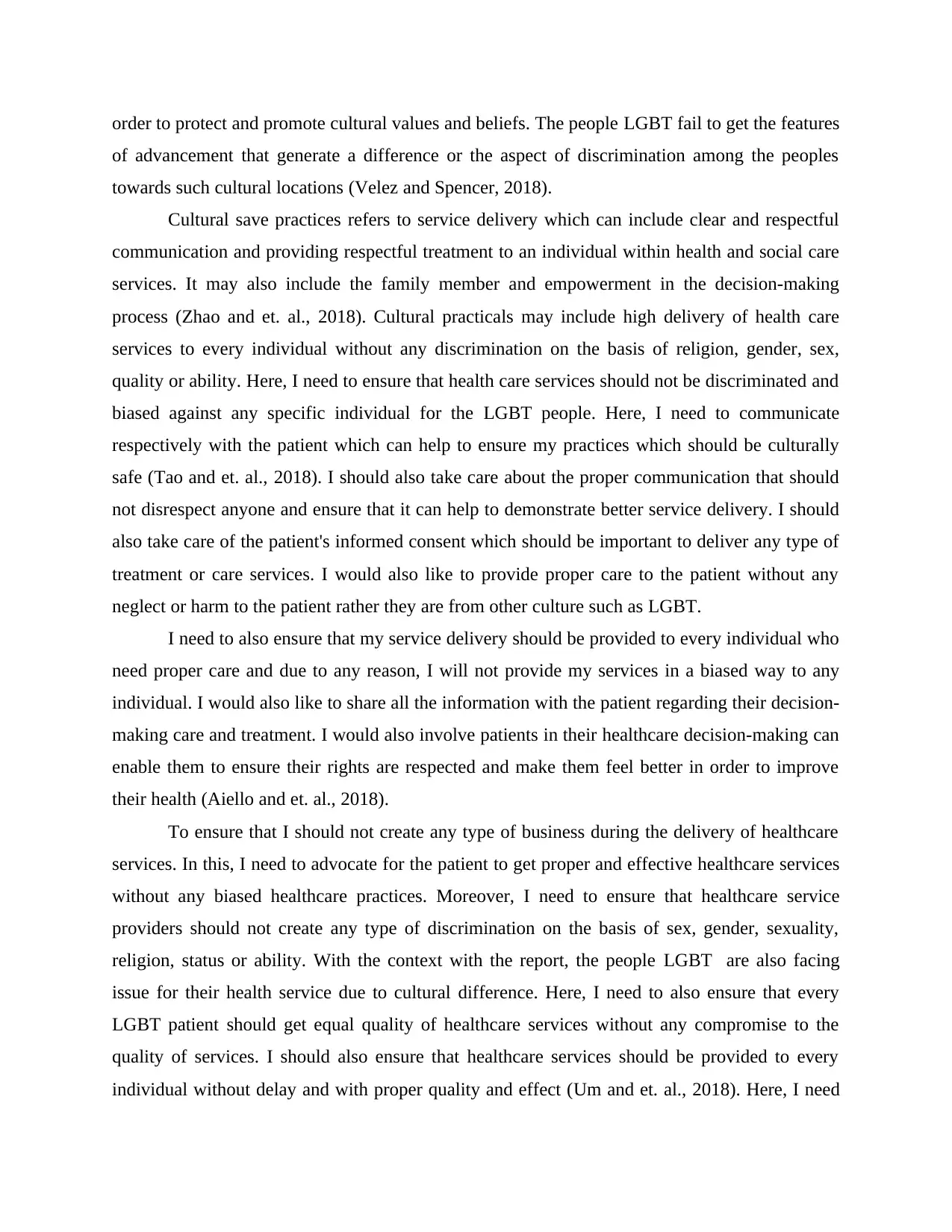
order to protect and promote cultural values and beliefs. The people LGBT fail to get the features
of advancement that generate a difference or the aspect of discrimination among the peoples
towards such cultural locations (Velez and Spencer, 2018).
Cultural save practices refers to service delivery which can include clear and respectful
communication and providing respectful treatment to an individual within health and social care
services. It may also include the family member and empowerment in the decision-making
process (Zhao and et. al., 2018). Cultural practicals may include high delivery of health care
services to every individual without any discrimination on the basis of religion, gender, sex,
quality or ability. Here, I need to ensure that health care services should not be discriminated and
biased against any specific individual for the LGBT people. Here, I need to communicate
respectively with the patient which can help to ensure my practices which should be culturally
safe (Tao and et. al., 2018). I should also take care about the proper communication that should
not disrespect anyone and ensure that it can help to demonstrate better service delivery. I should
also take care of the patient's informed consent which should be important to deliver any type of
treatment or care services. I would also like to provide proper care to the patient without any
neglect or harm to the patient rather they are from other culture such as LGBT.
I need to also ensure that my service delivery should be provided to every individual who
need proper care and due to any reason, I will not provide my services in a biased way to any
individual. I would also like to share all the information with the patient regarding their decision-
making care and treatment. I would also involve patients in their healthcare decision-making can
enable them to ensure their rights are respected and make them feel better in order to improve
their health (Aiello and et. al., 2018).
To ensure that I should not create any type of business during the delivery of healthcare
services. In this, I need to advocate for the patient to get proper and effective healthcare services
without any biased healthcare practices. Moreover, I need to ensure that healthcare service
providers should not create any type of discrimination on the basis of sex, gender, sexuality,
religion, status or ability. With the context with the report, the people LGBT are also facing
issue for their health service due to cultural difference. Here, I need to also ensure that every
LGBT patient should get equal quality of healthcare services without any compromise to the
quality of services. I should also ensure that healthcare services should be provided to every
individual without delay and with proper quality and effect (Um and et. al., 2018). Here, I need
of advancement that generate a difference or the aspect of discrimination among the peoples
towards such cultural locations (Velez and Spencer, 2018).
Cultural save practices refers to service delivery which can include clear and respectful
communication and providing respectful treatment to an individual within health and social care
services. It may also include the family member and empowerment in the decision-making
process (Zhao and et. al., 2018). Cultural practicals may include high delivery of health care
services to every individual without any discrimination on the basis of religion, gender, sex,
quality or ability. Here, I need to ensure that health care services should not be discriminated and
biased against any specific individual for the LGBT people. Here, I need to communicate
respectively with the patient which can help to ensure my practices which should be culturally
safe (Tao and et. al., 2018). I should also take care about the proper communication that should
not disrespect anyone and ensure that it can help to demonstrate better service delivery. I should
also take care of the patient's informed consent which should be important to deliver any type of
treatment or care services. I would also like to provide proper care to the patient without any
neglect or harm to the patient rather they are from other culture such as LGBT.
I need to also ensure that my service delivery should be provided to every individual who
need proper care and due to any reason, I will not provide my services in a biased way to any
individual. I would also like to share all the information with the patient regarding their decision-
making care and treatment. I would also involve patients in their healthcare decision-making can
enable them to ensure their rights are respected and make them feel better in order to improve
their health (Aiello and et. al., 2018).
To ensure that I should not create any type of business during the delivery of healthcare
services. In this, I need to advocate for the patient to get proper and effective healthcare services
without any biased healthcare practices. Moreover, I need to ensure that healthcare service
providers should not create any type of discrimination on the basis of sex, gender, sexuality,
religion, status or ability. With the context with the report, the people LGBT are also facing
issue for their health service due to cultural difference. Here, I need to also ensure that every
LGBT patient should get equal quality of healthcare services without any compromise to the
quality of services. I should also ensure that healthcare services should be provided to every
individual without delay and with proper quality and effect (Um and et. al., 2018). Here, I need
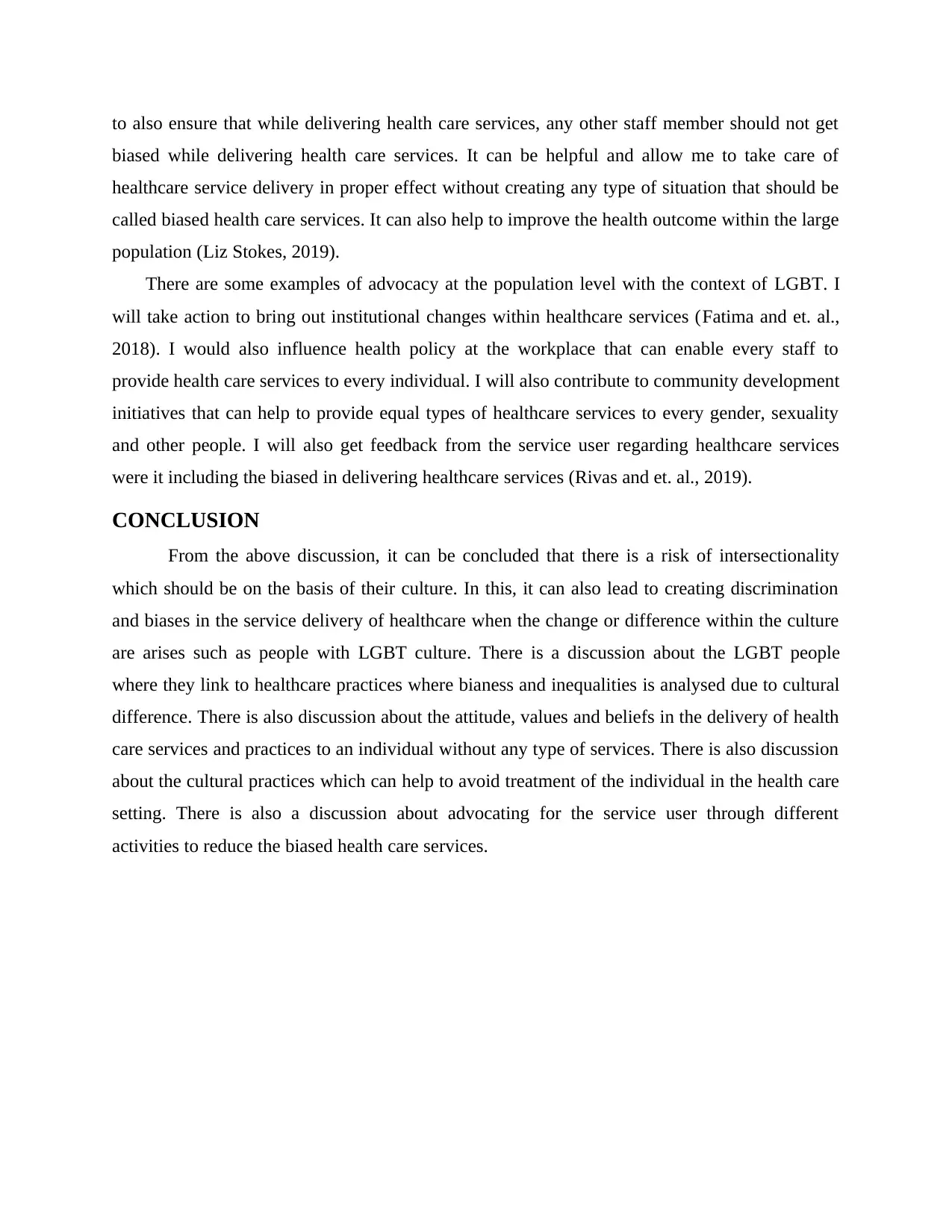
to also ensure that while delivering health care services, any other staff member should not get
biased while delivering health care services. It can be helpful and allow me to take care of
healthcare service delivery in proper effect without creating any type of situation that should be
called biased health care services. It can also help to improve the health outcome within the large
population (Liz Stokes, 2019).
There are some examples of advocacy at the population level with the context of LGBT. I
will take action to bring out institutional changes within healthcare services (Fatima and et. al.,
2018). I would also influence health policy at the workplace that can enable every staff to
provide health care services to every individual. I will also contribute to community development
initiatives that can help to provide equal types of healthcare services to every gender, sexuality
and other people. I will also get feedback from the service user regarding healthcare services
were it including the biased in delivering healthcare services (Rivas and et. al., 2019).
CONCLUSION
From the above discussion, it can be concluded that there is a risk of intersectionality
which should be on the basis of their culture. In this, it can also lead to creating discrimination
and biases in the service delivery of healthcare when the change or difference within the culture
are arises such as people with LGBT culture. There is a discussion about the LGBT people
where they link to healthcare practices where bianess and inequalities is analysed due to cultural
difference. There is also discussion about the attitude, values and beliefs in the delivery of health
care services and practices to an individual without any type of services. There is also discussion
about the cultural practices which can help to avoid treatment of the individual in the health care
setting. There is also a discussion about advocating for the service user through different
activities to reduce the biased health care services.
biased while delivering health care services. It can be helpful and allow me to take care of
healthcare service delivery in proper effect without creating any type of situation that should be
called biased health care services. It can also help to improve the health outcome within the large
population (Liz Stokes, 2019).
There are some examples of advocacy at the population level with the context of LGBT. I
will take action to bring out institutional changes within healthcare services (Fatima and et. al.,
2018). I would also influence health policy at the workplace that can enable every staff to
provide health care services to every individual. I will also contribute to community development
initiatives that can help to provide equal types of healthcare services to every gender, sexuality
and other people. I will also get feedback from the service user regarding healthcare services
were it including the biased in delivering healthcare services (Rivas and et. al., 2019).
CONCLUSION
From the above discussion, it can be concluded that there is a risk of intersectionality
which should be on the basis of their culture. In this, it can also lead to creating discrimination
and biases in the service delivery of healthcare when the change or difference within the culture
are arises such as people with LGBT culture. There is a discussion about the LGBT people
where they link to healthcare practices where bianess and inequalities is analysed due to cultural
difference. There is also discussion about the attitude, values and beliefs in the delivery of health
care services and practices to an individual without any type of services. There is also discussion
about the cultural practices which can help to avoid treatment of the individual in the health care
setting. There is also a discussion about advocating for the service user through different
activities to reduce the biased health care services.
⊘ This is a preview!⊘
Do you want full access?
Subscribe today to unlock all pages.

Trusted by 1+ million students worldwide
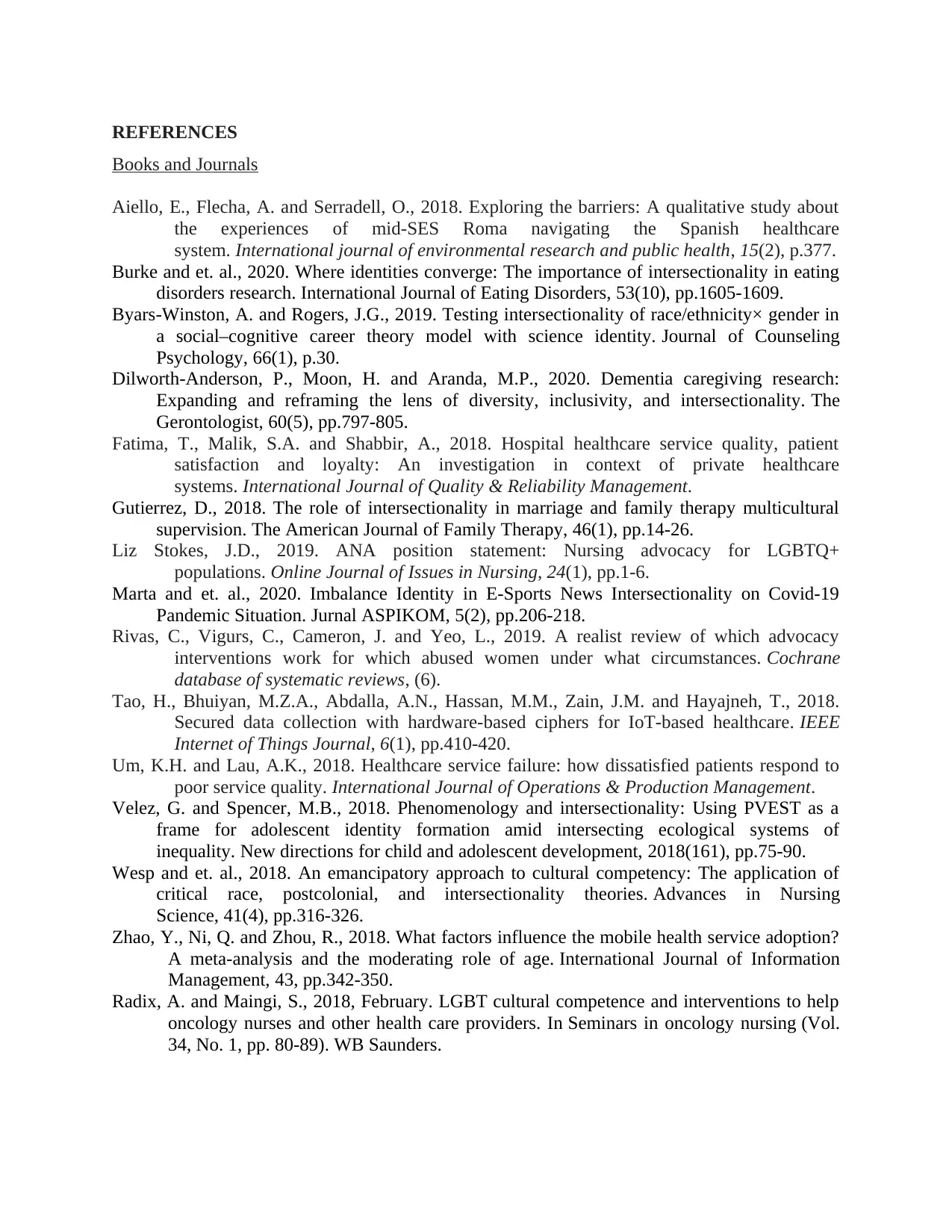
REFERENCES
Books and Journals
Aiello, E., Flecha, A. and Serradell, O., 2018. Exploring the barriers: A qualitative study about
the experiences of mid-SES Roma navigating the Spanish healthcare
system. International journal of environmental research and public health, 15(2), p.377.
Burke and et. al., 2020. Where identities converge: The importance of intersectionality in eating
disorders research. International Journal of Eating Disorders, 53(10), pp.1605-1609.
Byars-Winston, A. and Rogers, J.G., 2019. Testing intersectionality of race/ethnicity× gender in
a social–cognitive career theory model with science identity. Journal of Counseling
Psychology, 66(1), p.30.
Dilworth-Anderson, P., Moon, H. and Aranda, M.P., 2020. Dementia caregiving research:
Expanding and reframing the lens of diversity, inclusivity, and intersectionality. The
Gerontologist, 60(5), pp.797-805.
Fatima, T., Malik, S.A. and Shabbir, A., 2018. Hospital healthcare service quality, patient
satisfaction and loyalty: An investigation in context of private healthcare
systems. International Journal of Quality & Reliability Management.
Gutierrez, D., 2018. The role of intersectionality in marriage and family therapy multicultural
supervision. The American Journal of Family Therapy, 46(1), pp.14-26.
Liz Stokes, J.D., 2019. ANA position statement: Nursing advocacy for LGBTQ+
populations. Online Journal of Issues in Nursing, 24(1), pp.1-6.
Marta and et. al., 2020. Imbalance Identity in E-Sports News Intersectionality on Covid-19
Pandemic Situation. Jurnal ASPIKOM, 5(2), pp.206-218.
Rivas, C., Vigurs, C., Cameron, J. and Yeo, L., 2019. A realist review of which advocacy
interventions work for which abused women under what circumstances. Cochrane
database of systematic reviews, (6).
Tao, H., Bhuiyan, M.Z.A., Abdalla, A.N., Hassan, M.M., Zain, J.M. and Hayajneh, T., 2018.
Secured data collection with hardware-based ciphers for IoT-based healthcare. IEEE
Internet of Things Journal, 6(1), pp.410-420.
Um, K.H. and Lau, A.K., 2018. Healthcare service failure: how dissatisfied patients respond to
poor service quality. International Journal of Operations & Production Management.
Velez, G. and Spencer, M.B., 2018. Phenomenology and intersectionality: Using PVEST as a
frame for adolescent identity formation amid intersecting ecological systems of
inequality. New directions for child and adolescent development, 2018(161), pp.75-90.
Wesp and et. al., 2018. An emancipatory approach to cultural competency: The application of
critical race, postcolonial, and intersectionality theories. Advances in Nursing
Science, 41(4), pp.316-326.
Zhao, Y., Ni, Q. and Zhou, R., 2018. What factors influence the mobile health service adoption?
A meta-analysis and the moderating role of age. International Journal of Information
Management, 43, pp.342-350.
Radix, A. and Maingi, S., 2018, February. LGBT cultural competence and interventions to help
oncology nurses and other health care providers. In Seminars in oncology nursing (Vol.
34, No. 1, pp. 80-89). WB Saunders.
Books and Journals
Aiello, E., Flecha, A. and Serradell, O., 2018. Exploring the barriers: A qualitative study about
the experiences of mid-SES Roma navigating the Spanish healthcare
system. International journal of environmental research and public health, 15(2), p.377.
Burke and et. al., 2020. Where identities converge: The importance of intersectionality in eating
disorders research. International Journal of Eating Disorders, 53(10), pp.1605-1609.
Byars-Winston, A. and Rogers, J.G., 2019. Testing intersectionality of race/ethnicity× gender in
a social–cognitive career theory model with science identity. Journal of Counseling
Psychology, 66(1), p.30.
Dilworth-Anderson, P., Moon, H. and Aranda, M.P., 2020. Dementia caregiving research:
Expanding and reframing the lens of diversity, inclusivity, and intersectionality. The
Gerontologist, 60(5), pp.797-805.
Fatima, T., Malik, S.A. and Shabbir, A., 2018. Hospital healthcare service quality, patient
satisfaction and loyalty: An investigation in context of private healthcare
systems. International Journal of Quality & Reliability Management.
Gutierrez, D., 2018. The role of intersectionality in marriage and family therapy multicultural
supervision. The American Journal of Family Therapy, 46(1), pp.14-26.
Liz Stokes, J.D., 2019. ANA position statement: Nursing advocacy for LGBTQ+
populations. Online Journal of Issues in Nursing, 24(1), pp.1-6.
Marta and et. al., 2020. Imbalance Identity in E-Sports News Intersectionality on Covid-19
Pandemic Situation. Jurnal ASPIKOM, 5(2), pp.206-218.
Rivas, C., Vigurs, C., Cameron, J. and Yeo, L., 2019. A realist review of which advocacy
interventions work for which abused women under what circumstances. Cochrane
database of systematic reviews, (6).
Tao, H., Bhuiyan, M.Z.A., Abdalla, A.N., Hassan, M.M., Zain, J.M. and Hayajneh, T., 2018.
Secured data collection with hardware-based ciphers for IoT-based healthcare. IEEE
Internet of Things Journal, 6(1), pp.410-420.
Um, K.H. and Lau, A.K., 2018. Healthcare service failure: how dissatisfied patients respond to
poor service quality. International Journal of Operations & Production Management.
Velez, G. and Spencer, M.B., 2018. Phenomenology and intersectionality: Using PVEST as a
frame for adolescent identity formation amid intersecting ecological systems of
inequality. New directions for child and adolescent development, 2018(161), pp.75-90.
Wesp and et. al., 2018. An emancipatory approach to cultural competency: The application of
critical race, postcolonial, and intersectionality theories. Advances in Nursing
Science, 41(4), pp.316-326.
Zhao, Y., Ni, Q. and Zhou, R., 2018. What factors influence the mobile health service adoption?
A meta-analysis and the moderating role of age. International Journal of Information
Management, 43, pp.342-350.
Radix, A. and Maingi, S., 2018, February. LGBT cultural competence and interventions to help
oncology nurses and other health care providers. In Seminars in oncology nursing (Vol.
34, No. 1, pp. 80-89). WB Saunders.
Paraphrase This Document
Need a fresh take? Get an instant paraphrase of this document with our AI Paraphraser
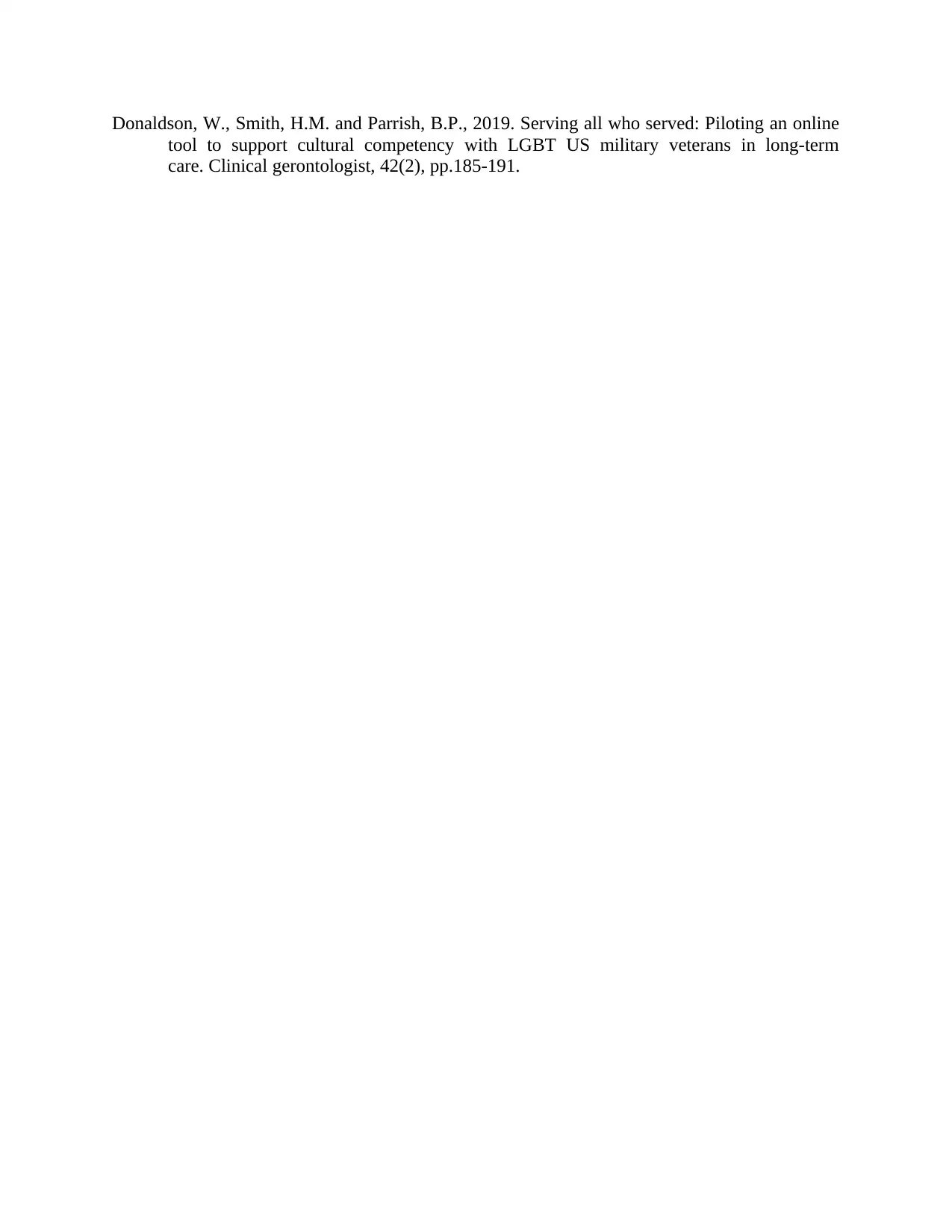
Donaldson, W., Smith, H.M. and Parrish, B.P., 2019. Serving all who served: Piloting an online
tool to support cultural competency with LGBT US military veterans in long-term
care. Clinical gerontologist, 42(2), pp.185-191.
tool to support cultural competency with LGBT US military veterans in long-term
care. Clinical gerontologist, 42(2), pp.185-191.
1 out of 8
Related Documents
Your All-in-One AI-Powered Toolkit for Academic Success.
+13062052269
info@desklib.com
Available 24*7 on WhatsApp / Email
![[object Object]](/_next/static/media/star-bottom.7253800d.svg)
Unlock your academic potential
Copyright © 2020–2025 A2Z Services. All Rights Reserved. Developed and managed by ZUCOL.





